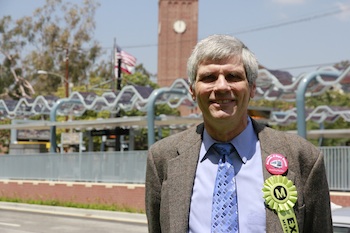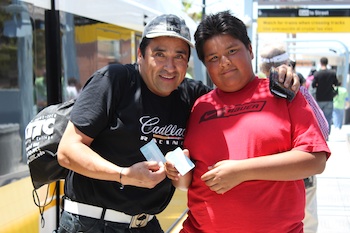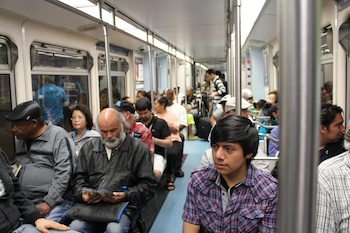Metro Opens Unfinished Phase I Of Expo Line To Fanfare

About 100 or so Angelenos milled around booths set up near the Expo Park/USC stop before hopping on board the newly operational line.
Despite some grumbles over the last few months about a two-year delay and unforeseen $200 million in additional expenses, those in attendance Saturday were for the most part just glad to see Phase 1 of the Expo Light Rail project complete.
David Roberts, director of local government relations at USC, stood on the platform at Expo Park, waiting patiently to depart for La Cienega Boulevard. "I love the commute from Downtown in my car," he said, "but this is going to be a great alternative to just jump on the train and be here on campus in 10 minutes."
Roberts said connectivity was the biggest draw for him—enough of an allure to bring him back to campus on a day off. "It's really making the commute and the connections here in Los Angeles much more convenient for people."
Undermining the opening weekend’s fanfare is the fact that the line is still technically a work in progress. Phase 1 includes just 8.6 miles of track—one mile of which will be added when the delayed Farmdale and Culver City stations open this summer. The stretch from Downtown to Culver City came with a $930-million price tag.
Phase 2, a 6.6-mile extension of the line to Santa Monica, broke ground in September of last year. Using funds from Measure R’s half-cent sales tax, the extension will cost about $1.5 billion, expected to be finished sometime in 2016.
Advocates behind the Expo Line movement seemed tired yet satisfied with the partitioned progress. “What’s sobering is, I’ve only been doing this for 22 years and I’m not done,” said Darrell Clarke, co-chair of Friends 4 Expo Transit. Formed in 2000, the grassroots organization has been the driving force behind gathering support for the line. At a VIP preview Friday, Clarke said he was thrilled to finally see his dream realized, repurposing the abandoned right-of-way track outside USC’s campus into a light rail.

“I mean, I was here a decade ago at a festival, tabling and saying, ‘We’re here supporting a train that would go from Downtown to Santa Monica right by here,’”—he turned and gestured broadly from one end of the line behind him to the other—“and here it is.”
Clarke’s Friends 4 Expo colleague Presley Burroughs said his involvement with the campaign reaches a little further back.
"Well I’ve been involved with this project since 1968," he said. "I was in junior high school, and my parents moved us from one side of the tracks to the other.” The Expo track carried its last passengers in 1953; freight delivery service continued to Santa Monica until 1987. The thundering noise of the freight service prompted Burroughs’ father to suggest a light rail along Exposition. “And that’s where it started.”
But it wasn’t until the late ‘90s that planning got underway. The city had suspended an extension project for the Wilshire subway, and Clarke jumped at the opportunity to push forward the Expo Line idea.
“We did a whole lot of presentations to community meetings,” Clarke said, “just talking about the importance of light rail, and the importance of this corridor.”
Jobs and convenience proved to be big selling points while promoting the project. “It’s not the typical situation, people from the suburbs commuting downtown—we have a downtown at each end," Clarke said. "There are so many jobs now on the Westside, but people can’t afford to live there. They're commuting in. So we desperately needed an alternative to just horrendous traffic.”
The bulk of Clarke and Co.’s work has consisted of raising awareness and rallying support for their solution. “The only reason we were successful is because so many people got together collecting petitions, talking about it, building the mass movement,” Clarke said. “It made it safe for the elected officials to support the project.”
Those backing officials include Mayor Antonio Villaraigosa and Supervisor Mark Ridley-Thomas, both of whom were in attendance at Friday’s preview. After rolling into the Expo Park station on the line’s inaugural trip, they took to the podium under a tent outside the Exposition Park Rose Garden.

L.A. County Supervisor and Metro Board member Zev Yaroslavsky said the line, which brings L.A.’s Metro Rail system to a total 87 miles, marks a great venture west. “Commuters to and from the western part of our county have been waiting a long time for this day and it is finally here,” he said. “[The Expo Line] will incorporate Exposition Park, the Crenshaw district and Culver City into the regional transportation network, serving one of the most underserved areas of our region.”
Clarke said he was grateful for the endorsements, even if it took city leadership a little while to get on board. “The biggest milestone, approval by the Metro board, came in mid-2001. So what are we talking, 11 years now?” he said, rolling his eyes. But, he continued, “From then on, we’ve had lesser hurdles. We’ve very much been involved in making sure that the project was moving forward, continuing to demonstrate the public support for why it is so darned important.”
Much of that Expo Line’s significance boils down to urban development and environmental factors. “L.A.’s population is not static,” Clarke said. “We’re continuing to grow. Where are these people going to live? [Is the city] going to do more sprawl development out in very remote places, with people making very long car drives to their jobs? Or are we going to have the more compact urban communities where people can walk and take transit?”
Burroughs put it a little more bluntly. “If you wish to sit in traffic and suck on somebody else’s tailpipe, that is your business,” he said. “Have at it, at $5-a-gallon gas. But if you want a safe, clean, quiet, efficient way to get to work, school, church, your recreation—it’s the only way to fly.”
And as evidenced by a diverse turnout Saturday, city-dwellers spanning all demographics can reap the benefits of the Expo Line. “The average rider, the average resident in this area, will be able to go from kindergarten through graduate school all without the necessity of purchasing a car. That is a savings of about $5,000 a year, tax-free,” Burroughs said. “That’s everybody. Everyone will benefit from this project.”
But not everyone has been so gung-ho about the project. Community members have voiced concerns about safety in station design. The layout of the Farmdale stop, for example, will force 700 Dorsey High School students to cross the train tracks every day.

And as for the safety of students crossing the train tracks, "I'm more worried about the adults than I am about the kids. I think the kids have a little bit more common sense," Roberts said. "There's signs. When you see signs that say, "Train Approaching," respect that. Stay out of the way."
Clarke said Metro has taken precise measures to ensure the safety of Expo Line riders.
“It’s using the same safety standards as the Gold Line to Pasadena and East L.A., which has had an excellent safety record—zero accidental deaths in nine years,” he said. Gates and fencing are built into each station, and Clarke said Metro officials had taken community education above and beyond past efforts in anticipation of the weekend’s opening. “Their ambassadors are out informing the community, helping the community recognize ‘Hey, there are trains here—you must be safe,’” he said. “So far, so good.”
Clarke didn't specifically address the accident during testing a little over a week ago, when an Expo Line train struck a motorist making a turn. But no incidents involving pedestrians have been reported since opening to the public—a modestly encouraging track record for champions of the Expo Line.
According to Burroughs, it's just the beginning of a promising road ahead.
“On to Santa Monica," he said. "We’re not done.”
Reach Deputy News Editor Catherine Green here; follow her here.



